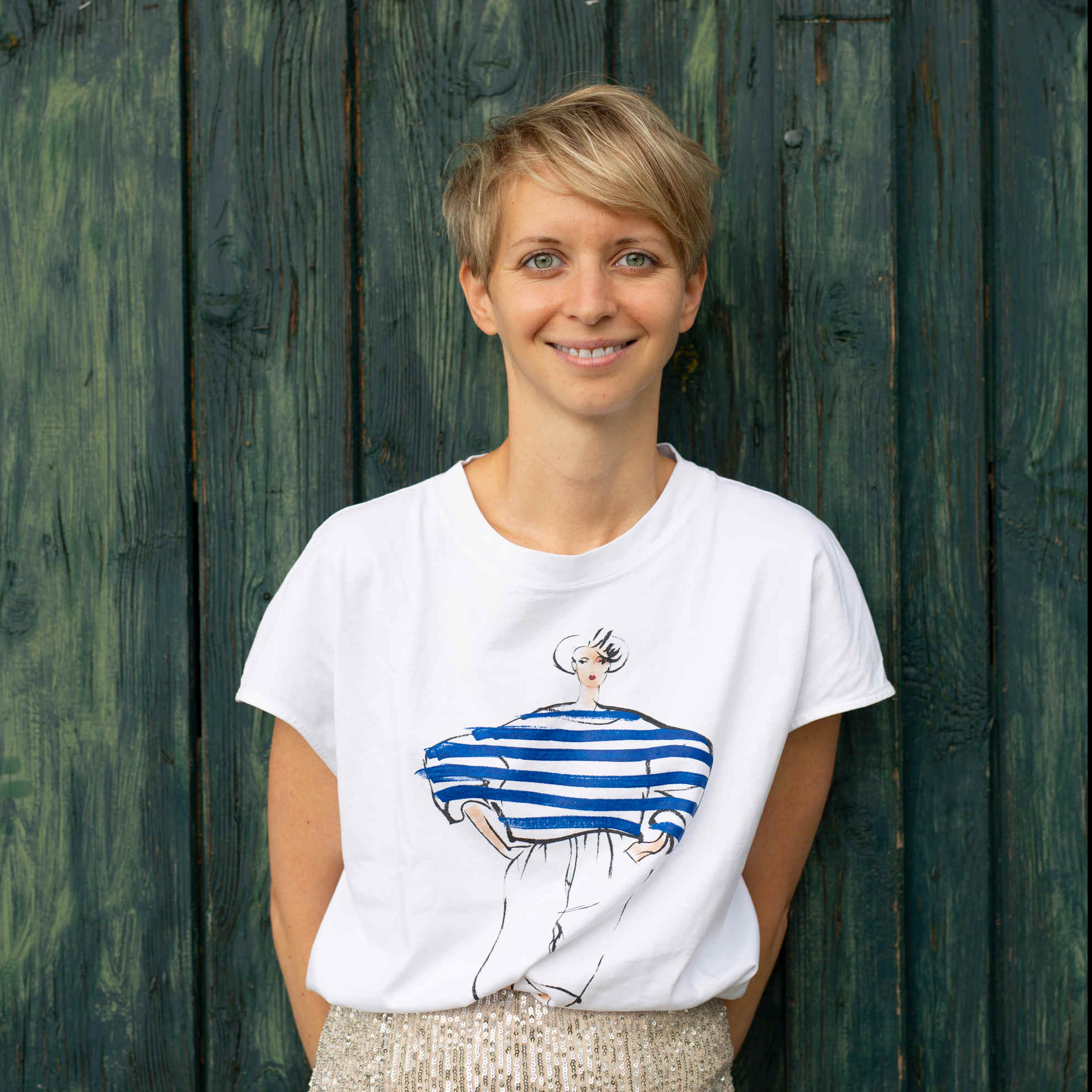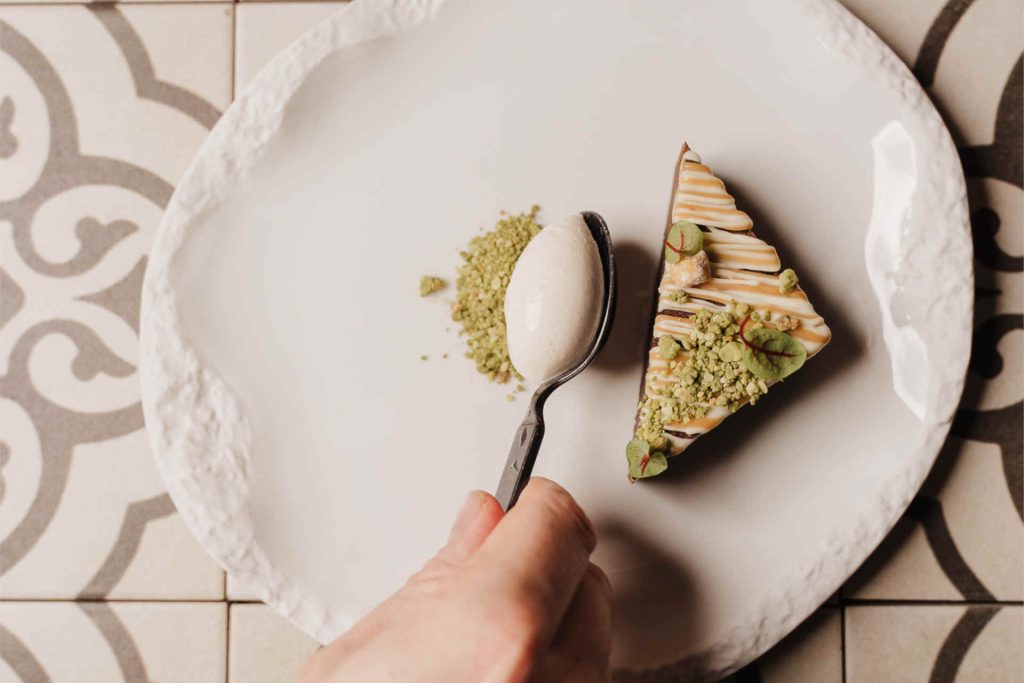
Cheese and chocolate have more in common than you might think. A symbiosis that opens up new worlds of flavor for guests.
His baked chocolate praline is already a classic at the Festival del Formaggio in Sand in Taufers, says Benjamin Sellemond. The young master confectioner and maître chocolatier from Feldthurns in South Tyrol uses Felchlin dark chocolate couverture and fills the praline with gray cheese from Hansi Baumgartner, a former Michelin-starred chef who now enjoys a high reputation as a cheese affineur with his Fromagerie Degust in Vahrn near Brixen.
“Grey cheese and dark chocolate have strong flavors, but they harmonize wonderfully—also in combination with caramelized onions or prunes,” says Sellemond, who is increasingly observing young chefs taking up the topic, led by Luca Wille, chef at the Hotel Bergblick in Fiss, Tyrol. “Cheese is very versatile, especially when melted. It can be used for petits fours, pralines, or mousse. However, since classic training does not teach how to process cheese, many chefs steer clear of it.”
Carina Trafoier runs an online store for bean-to-bar chocolates as a “table curator” and regularly hosts chocolate tastings. She attributes the harmony between cheese and chocolate on the palate to the fat content of both ingredients and their distinctive texture: “Both foods coat the mouth nicely and need time to develop on the palate.”
She first came into contact with the topic through a chocolate bar with Tuscan Pecorino cheese from the Brussels manufacturer Mike & Becky. “That was my eye-opening experience. After that, countless possible combinations came to mind: dark chocolate with blue cheese, milk chocolate with nutty soft cheese, durian fruit chocolate with mountain cheese.”
As with any food pairing, you can work with similar but also contrasting flavor profiles, for example, combining buttery French chocolate with creamy cheese or very dark, bitter chocolate with sweet cheese. Trafoier was particularly impressed by dark chocolate with an aged Comté. The crystalline, salty component of the cheese makes the combination reminiscent of salted caramel.
Nuart's Black Sheep, a fresh sheep's cheese matured in wood ash based on the French model, goes well with milk chocolate with a high cocoa content, such as the 66% Sourdough & Sea Salt chocolate with breadcrumbs from the English manufacturer Pump Street, which goes well with Jumi's Camembert Bianca. Trafoier calls the latter breakfast bread. "A 100% bar will be difficult to pair because it is inflexible on the palate and often sticky. A very crumbly or rubbery cheese doesn't work particularly well either.
Otherwise, you can let your imagination run wild, especially if you don't just use pure cheeses and chocolates, but add additional components, such as dark chocolate with fruit or affinated cheese."
Jan Eggers, chef at the Goldene Birn in Graz He combines Yuna chocolate with goat cheese, hay, and wheatgrass. “The hay ensures that the goat cheese is not too intense, while the white chocolate adds sweetness, so you need to use significantly less sugar. The wheatgrass has a refreshing acidity that gives the whole dish a certain lightness.”
Brunost, a Norwegian cheese with a delicate caramel flavor, pairs well with various chocolates, especially Beni Wild 66%, Piura 75%, and Esmeralder 42%, and can be combined as a cream with a classic brownie and vanilla ice cream, among other things. Braised sweet pears, together with a blue cheese cream “or simply sprinkled on top,” go perfectly with a water ganache made from Beni Wild 66%. “Every cocoa bean tells its own story – just like every cheese. Chocolate is all about fruitiness, acidity, spiciness, floral notes, and a subtle sweetness. With cheese, mineral, nutty, smoky, spicy, and sweet flavors are at the forefront. Both strong flavors complement each other wonderfully and make the combination of cheese and chocolate so unique.”
At the 2-star Ocean restaurant at the Vila Vita Parc Resort & Spa in Porches, Portugal, chef pâtissière Celestina Bengui has created a dessert made from goat cheese, fermented paprika, and almond blossoms. Balance is important to her: "Umami, acidity, saltiness – you need a little bit of everything. What I like about cheese is that it's so fatty. Almost like a substitute for butter. Add to that the acidity of fruit and something sweet."
When it comes to chocolate, she goes for Barry Callebaut (“The white chocolate in particular is less sweet than other brands”), and for cheese she prefers goat's cheese, Gouda, and Comté because of its fruity to nutty flavors. “Since the cheese is so rich and salty, it goes well with dark chocolate. Parmesan also works, for example as a cracker.”
Luise Grottenthaler, pastry chef at the two-star restaurant Söl'ring Hof on Sylt, also relies on fresh goat cheese – in this case from the Bavarian goat farm Peters Glück – and combines it in desserts with honey and rose or as a mousse with white air chocolate, pickled rhubarb, currant blossom sorbet, and various spring herbs, as well as in petit fours with caramelized country milk and plums. “Fresh goat cheese is easy to work with, and its consistency is reminiscent of quark. It can be very intense, but you can also use it subtly, like a kind of spice that is necessary for the dish but does not take center stage.”
She has tried blue cheese with dark chocolate for herself, “but in a restaurant, you have to have the right guests who are adventurous and like blue cheese.” For Grottenthaler, there is no question that cheese and chocolate go well together: “Cheese is served at the end of the menu, so why not in dessert?”
Table curator Carina Trafoier expresses a wish to the fine dining industry in this regard: “Just as there are cheese flights or cheese platters, there should also be chocolate flights or chocolate platters. Five high-quality, impressive chocolates for guests who are too full to order dessert but still want something sweet.”

Wild vegetables are more than just a trend—they are a From pink cauliflower to Bimi® wild pak choi, these varieties open up new possibilities for restaurants, hotels, and fine dining. They taste milder, are colorful, rich in vitamins—and can be perfectly prepared in no time.
From micro martinis to butterfly pea lattes – the bar world is being turned upside down. International bar culture is experiencing a trend that may seem small at first glance, but has great potential: mini drinks, signature serves, and no & low options that deliver less glass but more flavor. Combined with a growing focus on sustainability, storytelling, and sensory experiences, a new playing field is emerging for bartenders. Genusspunkt asked Marie Rausch and Sigrid Schot, two of the most exciting women in the bar scene, for their thoughts and also summarized the latest ideas from the World’s 50 Best Bars.
Imola is much more than just a race track: the city combines top-class cuisine, cultural monuments, and traditional producers to create an experience that delights connoisseurs, Italy fans, and curious travelers alike. From 2-star gastronomy at Ristorante San Domenico to creative pizza experiences and slow food osterie to historic libraries, palazzi, and award-winning wineries: this guide shows you the best places for cuisine, culture, and shopping—authentic, high-quality, and with real added value for your next visit to Imola.


Cheese and chocolate have more in common than you might think. A symbiosis that opens up new worlds of flavor for guests.